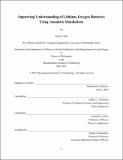| dc.description.abstract | Developing novel battery technologies is required to electrify hard to decarbonize industries. One such novel technology, lithium–oxygen batteries, has great potential for electric aviation but is hampered by our lack of detailed knowledge of the processes occurring inside the batteries. Thus, the projects in this thesis work to further our fundamental understanding of these battery systems using atomistic simulations.
In the first project, I explored one simulation methodology, ab initio molecular dynamics, commonly used to model battery systems. I examined the coordination environment of lithium ions in different solvents and compared the computational results to experimental data. The result was that the computationally calculated properties were heavily dependent on the starting configuration of the system, which illustrates the importance of both equilibration method and sufficient independent sampling for extracting experimentally relevant quantities from ab initio molecular dynamics simulations. Such details are often poorly documented or not justified in the literature, so this work indicates a need for increased attention to these details to ensure ab initio molecular dynamics studies are reproducible and physically accurate and thus useful.
In the second project, I utilized classical molecular dynamics to explore a wider range of properties for systems of lithium salts in twelve different solvents. This work combined a dedication to accuracy, as I compared the results from the computations to experimental data, with innovative ways of measuring ionic transport. I examined how solvent metrics combining different properties such as solvent donor number and viscosity that are relatively easy to measure experimentally correlate with the atomistic lithium transport mechanisms that are quite difficult to measure experimentally but readily accessible computationally, with the goal of eventually enabling the prediction of these transport mechanisms and thus a deeper understanding of the system on an atomistic scale from a few simple experiments. To my knowledge, this is the first time such solvent metrics have been examined with relation to ionic transport mechanisms in small molecule liquid solvent systems. | |
